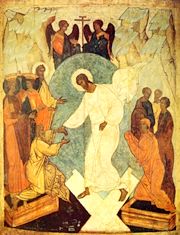As the world celebrated the Resurrection of Christ, a unique gathering of Orthodox Christian royalty took place in Europe. This special occasion brought together members of royal families from various countries, all united in their faith and tradition. The event was marked by a sense of camaraderie and shared spirituality, as these esteemed individuals came together to honor the sacred day.
Pascha, the Orthodox Christian celebration of Easter, is a time of great joy and renewal. For the royal families who gathered, it was a chance to reconnect with their heritage and with each other. The festivities were filled with warmth and laughter, as the royals shared stories and experiences, strengthening bonds that transcend borders and titles. In this moment, the world was reminded of the enduring power of faith and the unity it brings.
what is the significance of pascha in orthodox christianity
Pascha, also known as Easter in Western Christianity, holds profound spiritual significance in Orthodox Christianity. It is the cornerstone of Orthodox Christian faith, marking the Resurrection of Jesus Christ, which signifies the victory over death and sin, offering believers the promise of eternal life. This pivotal event is so central to Orthodox Christianity that all elements of the faith revolve around it, making Pascha the most important and joyous celebration of the ecclesiastical year.what are some traditional pascha customs in orthodox christianity
Pascha, the Orthodox Christian celebration of Easter, is marked by several traditional customs that emphasize the themes of hope, renewal, and unity. Some of these customs include: Blessing of the Paschal Basket: The Paschal basket, filled with foods and drinks, is blessed by the priest before the Paschal service. This symbolizes the renewal of life and the breaking of the Lenten fast. Paschal Troparion: The hymn "Christ is risen from the dead, trampling down death by death, and upon those in the tombs bestowing life!" is sung joyfully by the congregation, echoing the transformative power of the Resurrection. Paschal Greeting: The traditional greeting exchanged among Orthodox Christians during Pascha is "Christ is risen!" to which the response is "Truly He is risen!" This emphasizes the communal aspect of the celebration and the shared joy of the Resurrection. Paschal Candle: The Paschal candle, representing the Light of Christ, is lit during the Paschal Vigil service, symbolizing the triumph over darkness and death. Exchanging of Paschal Foods: The sharing of Paschal foods, such as red-dyed hard-boiled eggs, cheese, and bread, is a common practice among Orthodox Christians. These foods are often blessed during the Paschal service and are then distributed among the faithful, signifying the renewal of life and the breaking of the Lenten fast. Paschal Vespers: The Agape Vespers service, featuring Thomas' encounter with the Risen Lord read in a multitude of languages, is a significant part of the Paschal celebration. This service emphasizes the universal nature and message of Jesus' Resurrection. These customs, along with the liturgical practices and hymns, are integral to the celebration of Pascha in Orthodox Christianity, reinforcing the significance of Christ's resurrection and the hope of eternal life it offers.what are some traditional pascha foods in orthodox christianity
Traditional Pascha foods in Orthodox Christianity include: Kulichi: Easter bread, often tall and cylindrical, made of yeast dough, which is a domestic equivalent of artos. Pascha Cheese: A type of cheese that is traditionally served during Pascha, symbolizing the renewal of life and the breaking of the Lenten fast. Colored Eggs: Red-dyed hard-boiled eggs are a common Paschal food, signifying regeneration through the Blood of Jesus Christ—the Lamb of God Who replaced the annual animal sacrifices with His own perfect sacrifice. Lamb: In some Orthodox traditions, lamb is served as a Paschal food, symbolizing the sacrifice of Jesus Christ. Tsoureki Paschalino: A sweet Easter dessert bread, traditionally served in Serbian Orthodox families after Easter. These foods are often blessed during the Paschal service and are then distributed among the faithful, signifying the renewal of life and the breaking of the Lenten fast. |
| Crown Princess Elia of Albania with her father and brother. |
 |
| King Simeon II of Bulgaria. |
 |
| Prince Philip and Princess Danica with their son Prince Stefan. |
 |
| Grand Duchess Maria Vladimirovna of Russia. |
 |
| Grand Duke George Mikhailovich of Russia and his wife Princess Victoria. |
As we conclude this article about the Orthodox Christian royals celebrating Pascha, we hope that you have gained a deeper understanding of the significance of this sacred holiday in the Orthodox Christian tradition. The celebration of Pascha is a testament to the enduring power of faith and the unity it brings among believers. It is a time for reflection, renewal, and joy, as Orthodox Christians around the world come together to commemorate the Resurrection of Jesus Christ. Whether it is through the traditional foods, the vibrant customs, or the solemn liturgical services, Pascha is a celebration that transcends borders and cultures, uniting all who participate in its sacred rituals.
As we bid farewell to this article, we encourage you to continue exploring the rich traditions and customs of Orthodox Christianity. Whether you are a seasoned scholar or simply curious about the faith, we hope that this article has inspired you to delve deeper into the world of Orthodox Christianity. Remember that Pascha is not just a holiday, but a celebration of the hope and redemption that Jesus Christ brings to all humanity. May the joy and spirit of Pascha continue to inspire and guide you on your own spiritual journey.






No comments:
Post a Comment